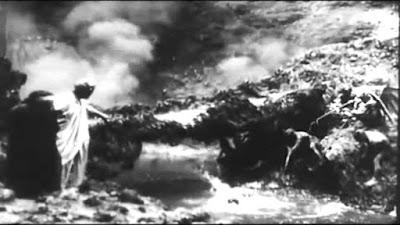Format: Internet video on Fire!

If you’ve never read The Divine Comedy, I recommend it. It’s pretty accessible for 14th Century literature, and a good translation makes for a really fun read. Well, at least for two-thirds of it. In the Ancient Greek tradition, a “comedy” is a story that starts with the characters at a low point and ends with them at a high point. Since this story begins in Hell and ends in Heaven, it is the ultimate comedy in that Greek sense. In Inferno, Dante witnesses the tortures of the damned. In the second book, Purgatorio, he sees the punishments inflicted on those who might still someday be purified to reach Heaven. In the final book, Paradisio, Dante sees Heaven. Bluntly, in Dante’s vision, Heaven is boring. That’s why the 1911 film adaptation focuses much more on Limbo, Hell, and Purgatory. The version I watched featured a prog-rock soundtrack that would have felt very much at home with Peter Gabriel in the cast and Tony Banks on the keyboards.
The film follows the trials of Dante’s Inferno pretty well, although it does leave out some specific areas of the various levels of Hell. The poet (Salvatore Papa) is denied entry to Paradise by being blocked by a trio of demons—Greed, Pride, and Lust. His idealized woman, Beatrice (Emilise Beretta, I think—the film isn’t clear), descends from Heaven and invokes the poet Virgil (Arturo Pirovano) to guide the poet through Hell.
What follows, then, is a tour of Dante Alighieri’s bleak vision of the afterlife. Before descending to Hell, he and Virgil talk with the poets and philosophers unlucky enough to have been born before the birth and ministry of Christ, which puts them forever in Limbo—not tortured, but without any hope of eternal salvation. This Limbo is, in fact, the first of nine circles of Hell—the one that doesn’t actually involve anything more than just the abandonment of hope for anything better or more.
As we descend, we get to see all of the tortures that await the unjust and evil. Each of the circles of Hell is specific to its sin and its torture, and there are various grades of tortures inflicted depending on the nuance of the crime in question. For instance, the Eighth Circle is for those who commit fraud. Seducers are forced to run while being whipped by demons while those who flatter are forced to live in a river of filth. Those who steal from the church are placed face down in a pit and have flames burn their feet. People who abused their public offices are tossed into a lake of boiling pitch, and on and on. Not all of the tortures of Dante’s book are depicted here—sorcerers have their heads twisted backwards, and are forced to thus walk backwards, their vision clouded by their tears. That would’ve been tough to depict in 1911.
Because Dante’s original work was not merely an expression of his own vision of Hell and punishment but an attack on the people he (and his patron) weren’t fond of, in each of the different parts of Hell, we’re going to encounters some people from Italy of the time, or from the generations prior. This was certainly a great deal more meaningful in the early 1300s, but to a modern audience not fully immersed in the politics of 14th Century Florence, most of these encounters are just random people who represent a particular sin.
Fortunately, the meetings with people like Count Ugolino aren’t the main draw of this spectacle. No, the real sell for L’Inferno is the various visions of the Hell that awaits the people we don’t like. That is, after all, what we are talking about here—Dante put the people he didn’t like in torturous situations to serve as examples and to give those people (or their memories) the middle finger. One imagines that the audience will do the same, as well as possibly see themselves in some of the described sins.
There are some fun visuals. The maimed, their bodies torn apart for sowing discord, is one of the great scenes of the film. Sure, it’s primitive and not hard to tell how the effect was achieved, but imagine an audience from 1911 watching a man carrying his own screaming head, or seeing Mohammad with his intestines hanging out. My guess is that it freaked a lot of people out. Same with the scene near the end where we witness Satan himself devouring a sinner.
The real reason for the film was almost certainly to scare people into giving up their particular sins and becoming more pious. I would guess that at the time, it worked pretty well. Today, probably not so much.
As a final note, a lot of Dante’s vision of Hell comes from the non-canonical Biblical work called The Apocalypse of Peter. People at the time thought it was holy scripture, but no one actually liked reading from it, so it was never made a formal part of the canon. Because of the popularity of Dante’s work, this vision of Hell is the one that pervades Western society, from film depictions to that particular plane of existence in Dungeons & Dragons.
Why to watch L’Inferno: Dante’s Inferno is a classic for a reason.
Why not to watch: It’s just a travelogue, although admittedly a travelogue through Hell.
